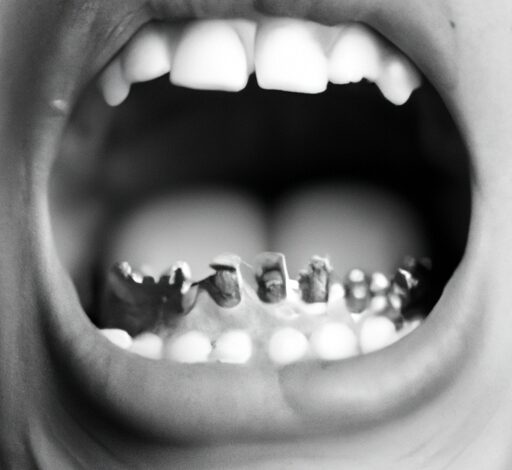What Does Dry Socket Look Like: Symptoms and Treatment

Appearance of Dry Socket
When a tooth is extracted, a blood clot forms in the empty socket to protect the bone and nerves underneath. If this blood clot is dislodged or dissolves before the socket has fully healed, it can leave the bone and nerves exposed to air, food particles, and bacteria. This condition is known as dry socket or alveolar osteitis.
The appearance of dry socket is distinct and can be easily recognized. The socket will appear empty and may have a whitish or grayish color instead of a healthy pink hue. The exposed bone may be visible, and there may be an unpleasant odor or taste coming from the area.
In addition to the visual appearance of dry socket, patients may experience severe pain that can radiate to the ear, eye, or neck. This pain is often described as throbbing or aching and can be exacerbated by eating or drinking.
If you suspect that you may have dry socket, it is important to contact your dentist or oral surgeon as soon as possible. They can provide treatment to alleviate your pain and promote healing in the affected area.
Symptoms of Dry Socket
Dry socket can be a painful and uncomfortable condition, and it is important to recognize the symptoms in order to seek treatment as soon as possible. Some common symptoms of dry socket include:
Severe pain: The pain associated with dry socket can be intense and throbbing, and it may radiate to other areas of the face, neck, or head.
Empty socket: The socket where the tooth was extracted may appear empty and have a whitish or grayish color instead of a healthy pink hue.
Bad odor or taste: There may be an unpleasant odor or taste coming from the affected area.
Swelling and inflammation: The surrounding tissue may be swollen and inflamed.
Difficulty opening the mouth: In some cases, dry socket can cause difficulty or pain when opening the mouth.
Fever: In rare cases, dry socket can cause a fever.
If you experience any of these symptoms after a tooth extraction, it is important to contact your dentist or oral surgeon as soon as possible. They can provide treatment to alleviate your pain and promote healing in the affected area.
Causes of Dry Socket
Dry socket occurs when the blood clot that forms after a tooth extraction is dislodged or dissolves before the socket has fully healed. This can expose the bone and nerves in the socket to air, food particles, and bacteria, causing pain and discomfort.
Some factors that can increase the risk of developing dry socket include:
Smoking: Smoking can delay healing and increase the risk of dry socket.
Oral contraceptives: Women who take oral contraceptives may be at higher risk of developing dry socket.
Poor oral hygiene: Poor oral hygiene can increase the risk of infection, which can lead to dry socket.
Trauma: Trauma to the extraction site, such as vigorous rinsing or spitting, can dislodge the blood clot and increase the risk of dry socket.
Wisdom teeth extraction: Wisdom teeth are more difficult to extract, and the risk of dry socket may be higher after their removal.
While these factors can increase the risk of developing dry socket, it is important to note that not everyone who experiences them will develop the condition. If you are at higher risk of dry socket, your dentist or oral surgeon may take extra precautions to promote healing and reduce the risk of complications.
Treatment Options for Dry Socket
If you are experiencing dry socket, it is important to seek treatment as soon as possible to alleviate your pain and promote healing. Your dentist or oral surgeon may recommend one or more of the following treatment options:
Medications: Over-the-counter pain relievers, such as ibuprofen or acetaminophen, may be recommended to manage pain. Your dentist or oral surgeon may also prescribe stronger pain medication if needed.
Dressings: A medicated dressing may be placed in the socket to promote healing and reduce pain.
Flushing: Flushing the socket with a saline solution can help remove debris and promote healing.
Antibiotics: If the socket is infected, your dentist or oral surgeon may prescribe antibiotics to treat the infection.
Surgery: In rare cases, surgery may be needed to clean the socket and promote healing.
In addition to these treatment options, your dentist or oral surgeon may recommend certain self-care measures to promote healing, such as avoiding smoking and using a warm compress on the affected area. With proper treatment and care, most cases of dry socket heal within a few weeks.
Understanding Dry Socket
Dry socket, also known as alveolar osteitis, is a painful condition that can occur after a tooth extraction. Normally, after a tooth is extracted, a blood clot forms in the empty socket to protect the bone and nerves underneath. If this blood clot is dislodged or dissolves before the socket has fully healed, it can leave the bone and nerves exposed to air, food particles, and bacteria.
Dry socket can be a painful and uncomfortable condition, and it is important to recognize the symptoms in order to seek treatment as soon as possible. Some common symptoms of dry socket include severe pain, an empty socket, bad odor or taste, swelling and inflammation, difficulty opening the mouth, and fever in rare cases.
Certain factors can increase the risk of developing dry socket, such as smoking, oral contraceptives, poor oral hygiene, trauma to the extraction site, and wisdom teeth extraction. However, not everyone who experiences these factors will develop dry socket.
Treatment options for dry socket include medications, dressings, flushing, antibiotics, and surgery in rare cases. Your dentist or oral surgeon may also recommend self-care measures to promote healing.
If you suspect that you may have dry socket, it is important to contact your dentist or oral surgeon as soon as possible. They can provide treatment to alleviate your pain and promote healing in the affected area.



